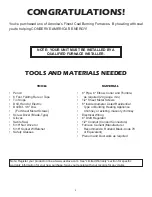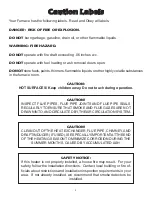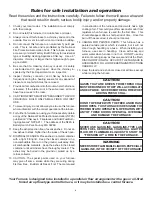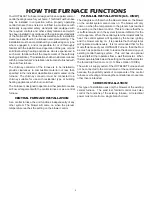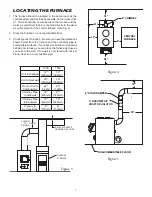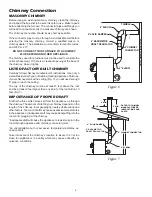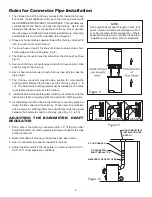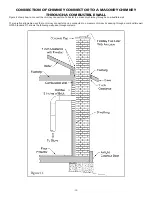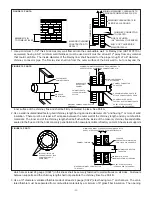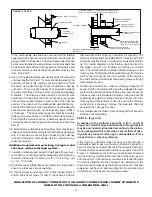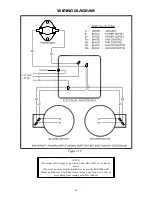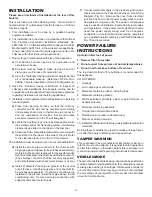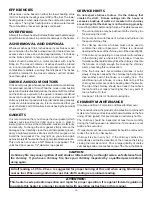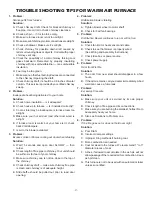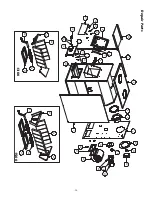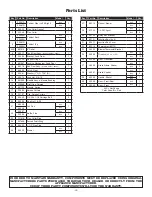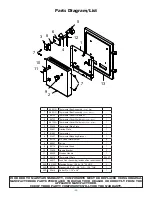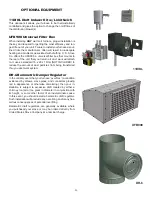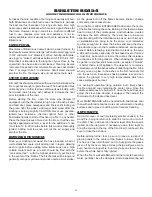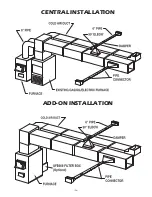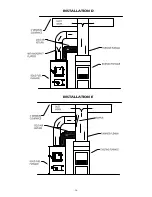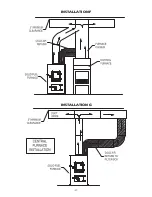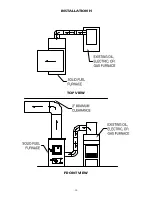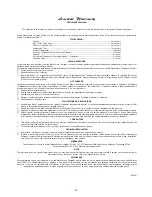
-15-
INSTALLATION
Please see all methods of Installation at the rear of this
booklet.
This is a furnace, not a free standing stove. You must direct
heated air from 8" outlets away from the furnace, or it will not
function properly.
1. This installation must be done by a qualified heating
equipment installer.
2. The installation is to be done in compliance with National
Fire Protection Association installation standards: No.
89M, 90B, 211, 70 (National Electrical Code) and Uniform
Mechanical Code 913, 6-4, in the states where applicable.
(Their code offers connecting smoke pipe connectors into
chimney with other fuel burning appliances.)
3. Rooms large in comparison with size of the appliance:
a)
Coal Burning Furnace need air for combustion and
circulation to house.
b)
Provision must be made to make up this air and not
starve gas or oil furnace of combustion air.
c)
Have the "Authority Having Jurisdiction" determine that
air is of adequate makeup. (Reference N.F.P.A. Nos.
30&54, Code for Installation of Gas & Oil Equipment).
4. Have the "Authority Having Jurisdiction" to inspect all
chimneys and installations for adequate venting and for
compliance with standard and local codes and regulations
regarding installation of coal burning appliances.
5. Installation for Supplemental Heat Application to Existing
Central System.
a)
Place Coal Burning Furnace so that the chimney
connector will be as short as practical and avoiding
unnecessary sharp turns in the smoke pipe connector
and the installation of devices that would create
excessive resistance to the flow of flue gases.
b)
Locate the Coal Burning Furnace as close as practical to
the existing central hot air heating system, maintaining
clearances as stated on the label on the fuel door.
c)
Clearance from combustible materials must comply with
those stated on the label on the side of the unit. Refer
to the clearance table in the front of this manual.
The installation must be made only on a noncombustible floor.
d)
Install the smoke pipe connector to the chimney with
26-gauge pipe and elbows (to be purchased separately),
maintaining the proper clearances for the specific model.
Seal the smoke pipe in the chimney with furnace cement.
(The chimney connector shall be securely supported,
and joints fastened with sheet metal screws or rivets.)
e)
Install 8" diameter heat pipe to plenum of the central
hot air furnace. Use 26-gauge pipe and connectors (to
be purchased separately). If central air conditioning is
installed in the plenum, install heat pipe above the air
conditioning unit. Secure heat pipe connection with
supports and sheet metal screws.
f)
Connect electrical supply in the electrical junction box
that is mounted on the back of the Furnace. See Wiring
Diagram (Fig. 16). Remove the cover from electrical
junction box and connect power supply wires to wires
designated, using wire nuts. The power cord supplied
may be used for installation, if permitted by local codes
and regulations. If the power cord supplied cannot be
used, the power supply wiring must be 90 degrees
centigrade in a metal cable and should be completed
by a qualified installer complying with NFPA Standard
No. 70 and local codes.
POWER FAILURE
INSTRUCTIONS
Operation after loss of power:
1. Remove filter if provided
2. Do not expect to keep home at normal temperatures.
3. Do not load fuel above bottom of feed door.
The top down method of fire building is recommended for
this appliance.
DO NOT BURN:
1.
Garbage;
2. Lawn clippings or yard waste;
3.
Materials containing rubber, including tires;
4. Materials containing plastic;
5.
Waste petroleum products, paints or paint thinners, or
asphalt products;
6.
Materials containing asbestos;
7. Construction or demolition debris;
8. Railroad ties or pressure-treated wood;
9.
Manure or animal remains;
10.
Saltwater driftwood or other previously saltwater saturated
materials;
Burning these materials may result in release of toxic fumes
or render the heater ineffective and cause smoke.
TAMPER WARNING
This coal heater has a manufacturer-set minimum low burn
rate that must not be altered. It is against federal regulations
to alter this setting or otherwise operate this coal heater in a
manner inconsistent with operating instructions in this manual.
VISIBLE SMOKE
The amount of visible smoke being produced can be an effective
method of determining how efficiently the combustion process
is taking place at the given settings. Visible smoke consist of
unburned fuel and moisture leaving your stove. Learn to adjust
the air settings of your specific unit to produce the smallest
amount of visible smoke.
Summary of Contents for 1300
Page 6: ... 6 DIMENSIONS OF FURNACE Figure 2 Model 1500 Figure 1 Model 1300 ...
Page 24: ... 24 CENTRAL INSTALLATION ADD ON INSTALLATION ...
Page 26: ... 26 INSTALLATION D INSTALLATION E ...
Page 27: ... 27 INSTALLATION F INSTALLATION G ...
Page 28: ... 28 INSTALLATION H TOP VIEW FRONT VIEW ...
Page 31: ... 31 NOTES ...
Page 55: ... 6 DIMENSIONS DE LA FOURNAISE Figure 2 Models 1500 Figure 1 Model 1300 ...


